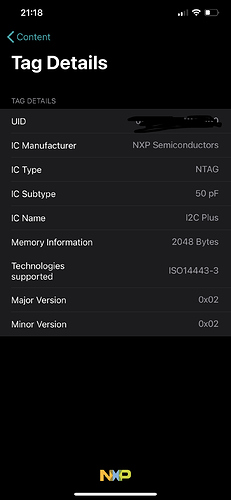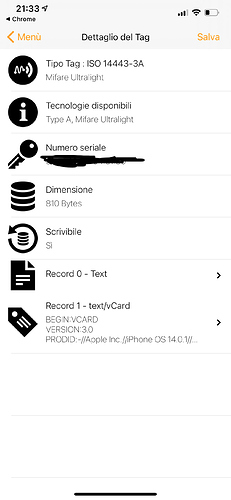TagWriter is a good option for both iOS and Android. It is made by NXP, the same company that makes the chip.
When i try use tagwriter for format
TagWriter is a good option for both iOS and Android. It is made by NXP, the same company that makes the chip.
[/quote]
hmm. use TagInfo (also made by NXP) and post the “Full Scan” data (minus your ID if you want to keep that private) … I need to see the user memory section
also what color is this xSIID?
Red
ok there should be a “full scan” option or section that shows the actual data in the user memory… i do not have the iOS version of TagInfo so I do not know where it is located, but it should exists as it does in the Android version.
No iPhone don’t have this section in app
Try nfc tools NFC Tools on the App Store ive had nothing but issues trying to use tagwriter nxp have messed with it.
hmm now try to write new data with nfc tools
ok so you have 2 records one blank text and the other an apple vCard, thats good means it works. Now try writing to the xsiid.
yeah now writing with NFC Tool has deleted the old ones and inserted the new one
Yes thats how NFC Tool does it, it always writes chip from the start so you queue all the records then hit write and it will write them all.
So manu thank’s for help me
Not a problem bud, Have fun!
If I get an xSIID, can I store a link or vCard that will automatically open, and also more arbitrary plaintext data? (I’m thinking of storing hand-encrypted backup/restore codes for my online accounts)
theoretically, yes. In reality, it depends on NDEF implementation / how hard it is to recover those codes. You can either add a NDEF record with a plain text type and hope the phone opens the first record automatically, or you can manually write data near the end of your tag (idk if that breaks NDEF storage, I could probably try it)
Assuming this is the xSIID, you could store the data in the 2nd kB of data, since that is not supported for NDEF records.
Do you have an example string (mainly length / number of them) that you want to store? I’m happy to try stuff out on my NTAG I2C test card for you.
Oh, and final question - are you an iPhone or android user?
Thanks for the reminder.
I really should get one of Amals NTAG I2C cards to add to my collection…
Thanks for the reply! I’ve seen you around on here sharing a lot of a brilliant info in understandable ways. Appreciate that ![]()
Yes, this would be the xSIID. I’ve read about that 2nd kB of data that’s inaccessible by NFC readers. But this still be read and written? What exactly is the capability of the 1st kB that the second one doesn’t have?
Let’s say my example string to store is something like:
Binance:
CEHNTOEBJSAJSMVQ
Facebook:
9083097845
34875983475
3847583745
93485345
GitHub:
ed4ac-92ba3a
4b982-cd2a89
Google:
2857 8838
1002 3948
Instagram:
2857 8838
2857 8838
2857 8838
Patreon:
sa8e-e83e-bceb-39ee
Reddit:
847774
9294311
(note: these are all fake)
Maybe a bit longer. Under 1,000 UTF8 characters seems doable for what I want to do. (I still have to figure out how to encrypt though, hopefully that won’t add to the character count.)
And then let’s say I want to have an NDEF record on the chip as well, that I can put a link to my website on, or my WiFi info.
I’m an iPhone user.
Could you test a setup like this? That would be amazing!
It would awesome to be able to read and write data to the 2nd kB because the recovery data I need is just plain text that doesn’t have to be NFC-enabled, as long as I can access it in an emergency (e.g., using an app I could download on a friend’s cell phone).
Thanks for the help!


